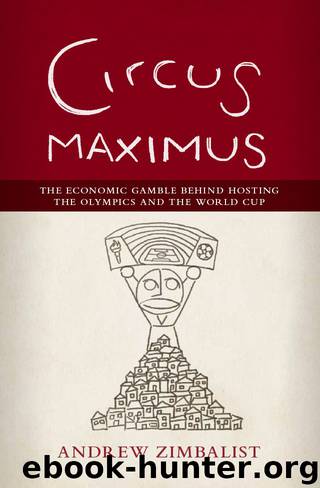Circus Maximus: The Economic Gamble Behind Hosting the Olympics and the World Cup by Andrew Zimbalist

Author:Andrew Zimbalist [Zimbalist, Andrew]
Language: eng
Format: epub
Publisher: Brookings Institution Press
Published: 2015-01-13T00:00:00+00:00
London
The 2012 London Olympic Games distinguished themselves in several ways. Most significant, the legacy planning was more detailed and more ambitious than in any previous Olympics. The central legacy goal was to rejuvenate five depressed boroughs in East London—Newham, Hackney, Tower Hamlets, Waltham Forest, and Greenwich. Although they each have their distinct traits, as a group they are characterized by rising population numbers, a relatively young and minority demographic, and comparatively high levels of social deprivation (measured by levels of employment, income, health, skills, education, housing, and crime, and certain attributes of the living environment).
In the nineteenth century and much of the twentieth, East London was a center for manufacturing and the city's docklands. Accordingly, it was a working-class neighborhood and poor relative to western districts in London. During the 1970s and 1980s, however, in the wake of labor troubles and technological change, the docks closed, and East London suffered extensive job loss in traditional manufacturing and processing industries. By the late 1980s a regeneration process had begun, first with the new docklands project, which was followed in 1990 by the launching of the more dispersed Thames Gateway scheme,63 and then by a movement of cultural and artistic businesses as well as nonprofit organizations into the area, seeking lower rents and prices. Small pockets of relative affluence began to appear in an area that was still economically depressed and crime-ridden. One outstanding problem was the paucity of public transportation connecting East London to the city center.
A major focus of London's Olympic Plan was to redevelop these five boroughs. It is important to emphasize, however, that a regenerative dynamic in favor of East London development had already begun in the 1990s. The London Docklands Development Corporation was established in 1985. The original scheme was to develop 8.8 million square feet of offices, hotels, shops, and restaurants and 8,000 parking spaces. The docklands light railway was the only form of public transportation connecting part of the area to the central city.
By the late 1990s, Canary Wharf, part of the docklands project, had begun to attract financial firms, and subsequently expanded to include other businesses and upscale housing. One study on the docklands project commented that “criticism has focused upon the removal of local democratic controls and the replacement of the existing population by a new, more prosperous group of young professionals…. Tower Hamlets, the borough in which Canary Wharf is located, experienced a significant change in population…. In 1981 the authority had 85 percent council (public) housing and 15 percent private housing and by 2008 nearly 60 percent was private housing.”64
The new Stratford rapid train station and nearby housing are part of a project of the London and Continental Railways that was initiated in 1997.65 Hence, by 2003, when the government decided to pursue its Olympic bid, an extensive transportation plan and related development plan were already in place.
Short-Run Effects
In May 2011, the London Organizing Committee for the Olympic Games (LOCOG) put out a request for proposals (RFP) seeking to identify a group to produce an economic impact study.
Download
This site does not store any files on its server. We only index and link to content provided by other sites. Please contact the content providers to delete copyright contents if any and email us, we'll remove relevant links or contents immediately.
The Secret History by Donna Tartt(18843)
The Social Justice Warrior Handbook by Lisa De Pasquale(12141)
Thirteen Reasons Why by Jay Asher(8792)
This Is How You Lose Her by Junot Diaz(6794)
Weapons of Math Destruction by Cathy O'Neil(6142)
Zero to One by Peter Thiel(5685)
Beartown by Fredrik Backman(5595)
The Myth of the Strong Leader by Archie Brown(5424)
The Fire Next Time by James Baldwin(5248)
How Democracies Die by Steven Levitsky & Daniel Ziblatt(5127)
Promise Me, Dad by Joe Biden(5087)
Stone's Rules by Roger Stone(5026)
A Higher Loyalty: Truth, Lies, and Leadership by James Comey(4843)
100 Deadly Skills by Clint Emerson(4840)
Rise and Kill First by Ronen Bergman(4701)
Secrecy World by Jake Bernstein(4644)
The David Icke Guide to the Global Conspiracy (and how to end it) by David Icke(4624)
The Farm by Tom Rob Smith(4434)
The Doomsday Machine by Daniel Ellsberg(4415)
